Back to Homepage / Blogs / Mar 2023
Confucius & the Temple of Literature
One of the spectacular sites to visit in Hanoi on our Halong Bay & Red River Cruises is the Temple of Literature or Van Mieu. Originally built in
1070 by Emperor Ly Thanh Tong, the temple is one of the many in Vietnam dedicated to
Confucius, the philosopher.
Spanning 54000 square meters, the beautiful Temple of Literature reflects the ancient architectural styles and relics. The temple complex is to the south of Thang Long
Imperial Citadel and is a 10-minute drive from Hoan Kiem lake.
The Temple of Literature is the most famous and iconic structure in the complex. Apart from its unique architecture, it is known for its status as a symbol of education and
literature in Vietnam. The complex has a long and storied history, and it continues to be one of the most popular tourist destinations in Hanoi.
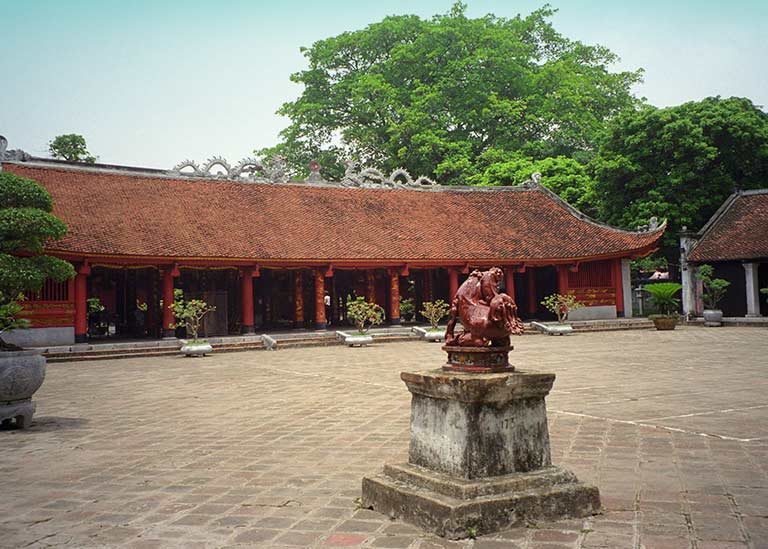
Temple of
Literature, Hanoi
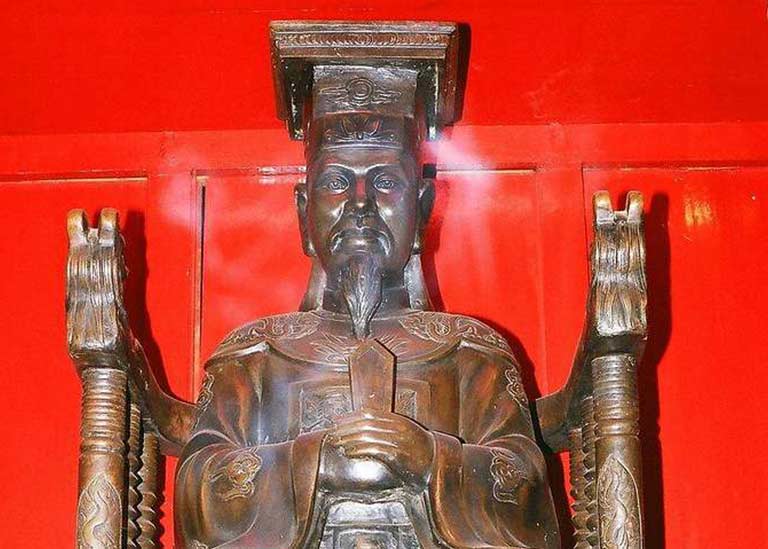
Emperor Ly Thanh Tong
Confucious, the Chinese philosopher
Confucius was a Chinese philosopher who lived in the 6th century BCE (c. 551 – c. 479 BCE). He is best known for his philosophical teachings, which have been incredibly
influential in Chinese culture. Confucius believed in the importance of personal and government morality, respectful relationships, and justice. His teachings have been
respected by many people throughout history and continue to be studied today.
Confucius's ideas were later turned into a system of thought known as Confucianism, which was influential throughout East Asia for centuries. Confucianism emphasized the
importance of filial piety, duty, propriety, and education. Confucius believed that if people lived according to these principles, they would create a harmonious society.
Confucian temples exist in Vietnam for a variety of reasons. For one, Confucianism was the state religion of Vietnam for many centuries. These temples, built to honor the
memory of the philosopher and promote the study of his philosophy, can be traced back to the 10th century CE. The Confucius temples are a reminder of Vietnam's long history and
its cultural ties to China.
Additionally, the temples served as a place for scholars to study and engage in intellectual conversations. Today, the temples continue to play an important role in
Vietnamese culture and society.
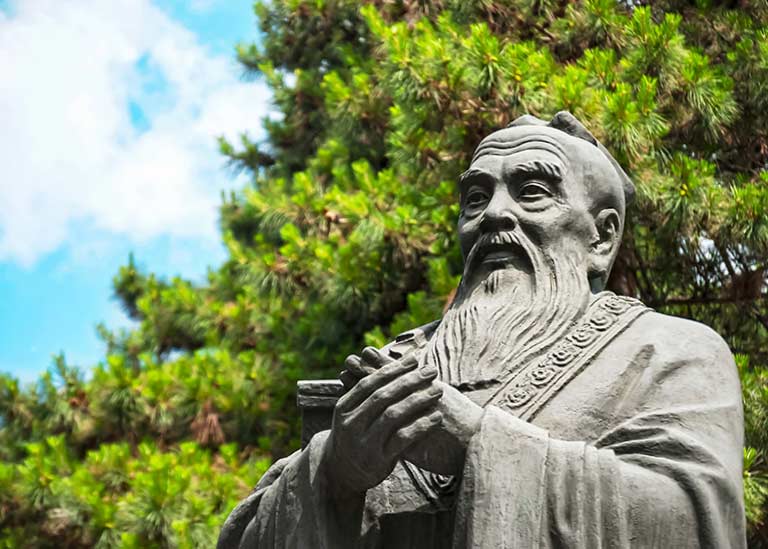
Confucius, the Chinese philosopher
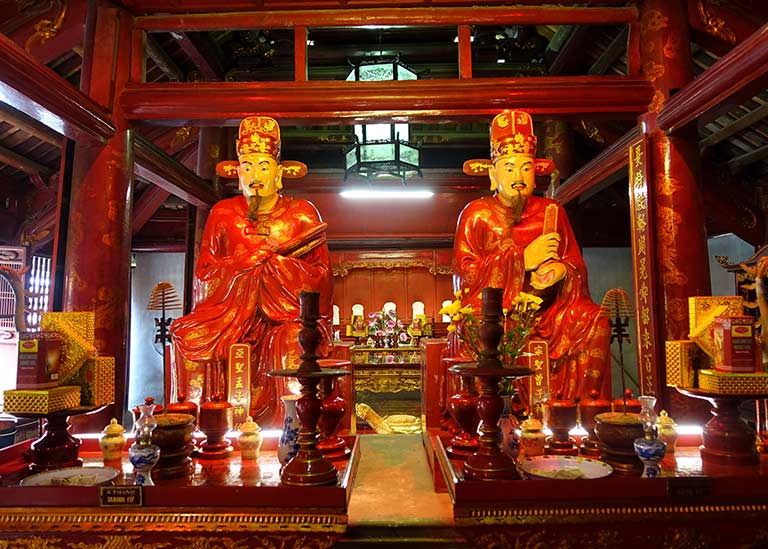
Carvings of Disciples
The history behind the Temple of Literature
The founder of the temple, Emperor Ly Thanh Tong (1023 – 1072), was the eighth ruler of the Kingdom Dai Viet and the third monarch in the Ly dynasty.
He not only reduced some harsh laws but promoted agriculture and developed many Buddhist and Confucianist institutions. The Temple of Literature is the most famous one among
these institutions.
Confucius historians state that the temple was built in the autumn of 1070 during the eighth lunar month. This is described in their book "Dai Viet Su Ky Toan Thu" (Complete
History of the Great Viet).
In addition to the statues of Confucius, the temple also had carvings of four of his best disciples (Yan Hui, Mencius, Zengzi, and Zisi). The paintings of 72 other Confucian
scholars were also done. In all four seasons, according to historians, ceremonies were performed to honor Confucius, his disciples, and scholars.
The Imperial Academy
A few years later in 1076, under the reign of the fourth monarch of the Ly dynasty, Ly Nhan Tong, "Quoc Tu Giam" (Imperial Academy) was established behind the Temple of
Literature.
The Imperial Academy was the first university in Vietnam dedicated to educating the royalty, nobles, bureaucrats, and other elite members of the community. The university
continued to be prominent until 1779. However, it lost its importance when a new imperial academy was founded by the monarchs of the Nguyen dynasty, the last dynasty in
Vietnam.
While Emperor Ly Nhan Tong built the Imperial Academy, it was enlarged in 1236 and named Quoc Hoc Vien. During the Le dynasty, the Academy was developed further and came to
be known as Thái Hoc Vien. Apart from the Minh Luân house, classrooms, dormitories, and a storehouse were added.
In 1484, Le Thanh Tong, the presiding king established stone slabs or 'stele' for people who cleared the doctoral exam that was placed on a turtle. Turtles, in ancient
cultures, were seen as symbols of wisdom and longevity. During this king's reign, 12 such doctoral exams were held once in three years.
Later in 1906, the complex housing the Imperial Academy and Temple of Literature was recognized as a Monument Historique (historical monument) under the French
protectorate.
However, the French demolished certain parts of the temple between 1945 and 1954 to care for the sick and wounded during the war. Attempts were made to restore, reconstruct,
and repair the temple subsequently.

The Great Gate

House of Stelae - Turtles
The architecture and the layout
The design of the Temple of Literature is based on the birthplace of Confucius at Qufu, in the Shandong province of China.
The Temple of Literature features five courtyards that are arranged in an orderly manner. The Great Gate which is the entrance to the complex has four tall pillars,
featuring two stelae on either side ordering horsemen to dismount. A bronze bell is placed above the gate which was used to signal an important person's arrival. If you look
closely, you can see several patterns on the bell including a phoenix that denotes beauty as well as a dragon representing power.
From the Great Gate, three pathways run through the complex. The center pathway was meant for the kind, the left pathway was for administrative Mandarins while the pathway
on the right was for the military. Malleable bricks separate the relics from the external space.
The first courtyard: The Great Middle Gate opens to the first courtyard (Dai Trung Mon) and is flanked by the 'Talent' and 'Virtue' gates on either side.
Reflecting the architectural flavor of the Le dynasty, the gate has a red shoe-shaped roof and wooden pillars. The ground is paved with bricks made locally.
These gates denote the expectation that the King had towards students of the Imperial Academy. You can also spot a fish symbol atop the gate. According to the local legend,
God holds competitions annually for the fish. The fish that can jump over the tallest waves to get across the waterfall wins the competition and is turned into a dragon.
The fish is also used symbolically to remind students of the constant efforts they need to make to pass exams and become knowledgeable.
The second courtyard: The most important structure here is the Khue Van Cac, which is a red, wooden pavilion built on white stone columns. The ornate roof
has a brass bell and two circular windows.
As the symbol of Hanoi, Khue Van Cac is featured on the Vietnamese dong banknote of 100,000 denomination. Established in 1805, Khue Van Cac translates to "the Pavilion of
Constellation." While 'Cac' means pavilion, Khue is the constellation that represents literature.
The structure, on the whole, represents the importance the Vietnamese gave to education.
The first and the second courtyards, featuring manicured lawns and large trees were the places where scholars would relax.
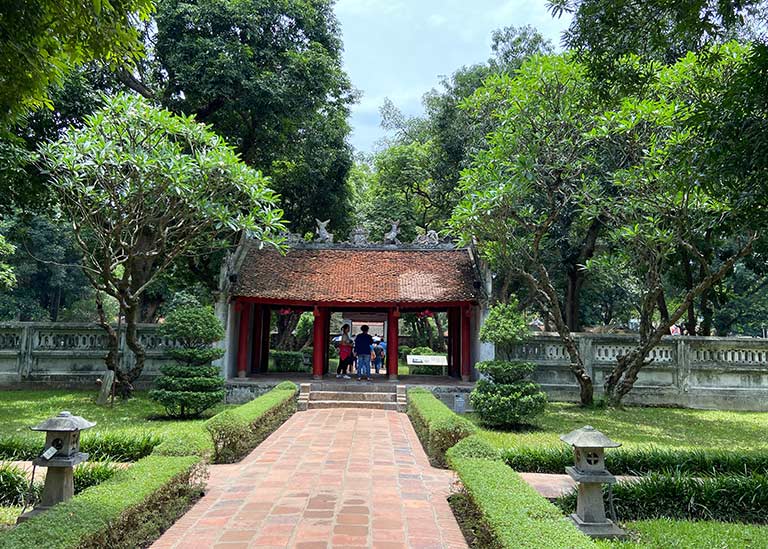
The first
courtyard gate

The second courtyard
pavilion
The third courtyard: The third courtyard is called the Well of Heavenly Clarity or the Thien Quang well. The square-shaped well not only adds a layer of
tranquility to the complex but helped students dress up and see themselves before entering the inner part.
The unique "house of stelae" can be seen in the courtyard. The 82 stelae feature the birthplaces and names of 1307 graduates of 82 different royal examinations. Carved out
of bluestone, the stelae sitting on the top of turtles were symbols of good luck for students. Before writing the exams, the students would rub the turtles' heads.
The fourth courtyard: Known as Dai Thanh Mon or the gate to success, features altars to Confucius and the impressive House of Ceremonies. Antique lanterns
hang from wood beam ceilings and red columns while you can find an altar right in the middle of the courtyard. This altar is typical of the ones that you can find in all
Vietnamese homes. As the most sacred spot in the house, the altar is where families worship their ancestors.
A pair of cranes and turtles flank the altar on either side. While these are good friends, they represent eternity and harmony.
The fifth courtyard: The fifth courtyard houses the Imperial Academy (Thai Hoc Hall) and features two floors. On the ground floor, you can see a sculpture
of Chu Van An, the first rector and a great teacher of the Imperia Academy. Artifacts and pictures depicting Confucian education can also be seen on this floor.
The upper floor is dedicated to the three kings -
- Ly Thanh Tong (the founder of the Temple of Literature),
- Ly Nhan Tong (founder of the Imperial Academy), and
- Le Thanh Tong who built the stelae.
These three kings are worshipped as the ones who contributed the most to the development of the Temple of Literature and the Imperial Academy.
Just outside the Imperial Academy, you can find a drum and the Bich Ung bell, that denote the majesty and solemnity of the complex.
The other places of interest in the complex are the Lake of Literature (Minh Duong Lake or Ho Giam) in front of the Literature Temple's main gate. In the middle is the Kim
Chau mound, where poetry commentary used to take place.
On the west side, is the Giam Garden replete with octagonal houses and ornamental plants. This place acts as the venue for artistic and cultural activities including dragon
dance and puppet shows during the holidays.

Well of
Heavenly Clarity

Drum outside Imperial
Academy
A beautifully preserved historic site
The Temple of Literature in Hanoi is a beautiful and historic site that is well worth a visit. The most impressive fact is that despite multiple wars and demolitions, the
temple is beautifully preserved. It is a great place to learn about Vietnamese history and culture. Apart from exploring the courtyards, artifacts, and shrines in detail, you
can participate in traditional ceremonies.